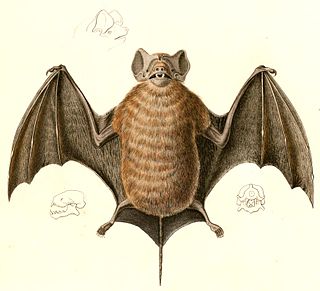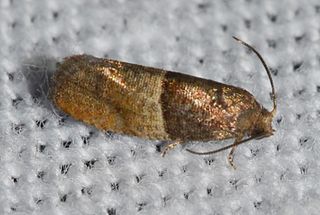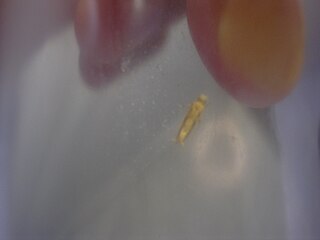Related Research Articles

Vigna aconitifolia is a drought-resistant legume, commonly grown in arid and semi-arid regions of India. It is commonly called mat bean, moth bean, matki, Turkish gram or dew bean. The pods, sprouts and protein-rich seeds of this crop are commonly consumed in India. Moth bean can be grown on many soil types, and can also act as a pasture legume.

The velvety free-tailed bat or Pallas's mastiff bat, is a bat species in the family Molossidae.

Larisa is a genus of moths belonging to the subfamily Olethreutinae of the family Tortricidae. It contains only one species, Larisa subsolana, which is found in North America, where it has been recorded from Alabama, Florida, Georgia, Illinois, Indiana, Kentucky, Maine, Maryland, Massachusetts, Minnesota, Mississippi, Missouri, New York, Ohio, Oklahoma, Ontario, Quebec, South Carolina, Tennessee, Texas, Virginia and West Virginia.

Anthanassa frisia, the Cuban crescentspot, Cuban checkerspot or Cuban crescent, is a butterfly of the family Nymphalidae. Subspecies tulcis is known by the common names pale-banded crescent or Tulcis crescent; it is treated as a species by some authors. The nominate subspecies is found in the West Indies and southern Florida, with strays to northern Florida. Subspecies tulcis is found from Argentina north through Central America and Mexico to southern Texas, strays to west Texas and southern Arizona. Other subspecies are resident to South America.
Stigmella myricafoliella is a moth of the family Nepticulidae. It has been recorded in North America from Florida and Nova Scotia.
Dryadaula terpsichorella, the dancing moth, is a moth of the family Tineidae. It is native to south-eastern Polynesia, Samoa and Fiji, but has also been recorded from Hawaii and more recently from Florida and California. The common name is derived from the characteristic dancelike gyrations it goes through when it alights. It was first described by August Busck in 1910.

Erechthias minuscula, the erechthias clothes moth, is a moth of the family Tineidae. It was first described by Lord Walsingham in 1897. It is widespread and has been recorded from Africa, Sri Lanka, Java, Australia, the Caroline Islands, Fiji, Samoa, the Marquesas, the West Indies, Hawaii and Florida.

Lorita scarificata, the chrysanthemum flower borer or Lora Aborn's moth, is a moth of the family Tortricidae. It is native to North America and is an introduced species in Hawaii.

Adaina bipunctatus is a moth of the family Pterophoridae. It is found in the United States, including Florida and Mississippi. It has also been recorded from Trinidad, the West Indies, Brazil and Ecuador.

Cochylis ringsi, Rings' cochylid moth, is a species of moth of the family Tortricidae. It is found in the United States, where it has been recorded from Iowa and Texas to Maryland and Florida.
Chrysendeton nigrescens is a moth in the family Crambidae. It is found on North America, where it has been recorded from Alabama, Florida and Georgia. The habitat consists of pitcher plant bogs.
Rhectocraspeda periusalis, the eggplant webworm moth, is a moth in the family Crambidae. It was described by Francis Walker in 1859. It is found in the West Indies and from the United States, where it has been recorded from Florida, North Carolina, Ohio, Oklahoma, South Carolina and Tennessee, south through Mexico and Central America to South America, including Ecuador, Brazil, Guyana, Trinidad and Tobago and Suriname.
Pseudogalleria inimicella, the inimical borer moth, is a moth in the family Tortricidae. It was described by Zeller in 1872. It is found in North America, where it has been recorded from Alabama, Arkansas, Florida, Georgia, Illinois, Indiana, Kentucky, Maine, Maryland, New Hampshire, North Carolina, Ohio, Oklahoma, Ontario, South Carolina, Tennessee, Texas and West Virginia.

Aroga trialbamaculella, the red-striped fireworm moth, is a moth of the family Gelechiidae. It is found in the United States, where it has been recorded from Maine to Florida and from Illinois to Texas.

Arogalea cristifasciella, the stripe-backed moth, is a moth of the family Gelechiidae. It is found in North America, where it has been recorded from Alabama, Arkansas, Connecticut, Florida, Georgia, Illinois, Indiana, Kansas, Kentucky, Louisiana, Maine, Maryland, Massachusetts, Michigan, Mississippi, Missouri, New Hampshire, New Jersey, New York, North Carolina, Ohio, Oklahoma, Ontario, Quebec, South Carolina, Tennessee, Texas, Virginia, West Virginia and Wisconsin.

Diastictis argyralis, the white-spotted orange moth, is a moth in the family Crambidae. It was described by Jacob Hübner in 1818. It is found in North America, where it has been recorded from Colorado, Florida, Georgia, Indiana, Maine, Maryland, Mississippi, North Carolina, Ohio, Ontario, South Carolina, Tennessee, Texas and Virginia.

Glyphidocera juniperella, the juniper tip moth, is a moth of the family Autostichidae. It is found in North America, where it has been recorded from Alabama, Florida, Indiana, Louisiana, Maryland, Mississippi, Oklahoma, South Carolina, Tennessee and West Virginia.
Eudeilinia luteifera, the southern eudeilinea moth, is a moth in the family Drepanidae. It was described by Harrison Gray Dyar Jr. in 1917. It is found in the United States, where it has been recorded from Texas to Florida.

Dichomeris flavocostella, the cream-edged dichomeris moth, is a moth in the family Gelechiidae. It was described by James Brackenridge Clemens in 1860. It is found in North America, where it has been recorded from southern Quebec and Maine to Florida, west to Texas and north to Manitoba.

Antaeotricha floridella is a moth of the family Depressariidae. It is found in North America, where it has been recorded from peninsular Florida.
References
- ↑ "GlobIZ search". Global Information System on Pyraloidea. Retrieved 2014-07-15.
- ↑ Moth Photographers Group at Mississippi State University
- ↑ Bug Guide
| This Petrophila-related article is a stub. You can help Wikipedia by expanding it. |